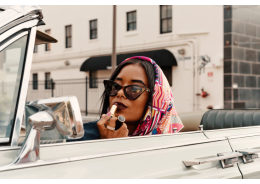The birth of Hermès scarves is a process of combining creativity and technology. There are more than 40 artists from different countries designing patterns at Hermès headquarters. According to the theme, these artists spend 6 months carefully scrutinizing and confirming.In addition, there is a most complex process - screen preparing, which takes the master up to 1,000 hours to implement the drawings on screens, then dye.
.jpeg)
Hermès' silk scarves are made of countless exquisite craftsmanship, of which is its complex and changeable color matching. In Rio, Hermès' own color matching team completed all the color matching, the secret of the process of color matching is to mix natural glue with different proportions of pigments. So far, Hermès' color library has 75,000 different kinds of color matching.
.jpeg)
The world of Hermes scarves is a colorful world! Let's take a look at the classic silk scarf patterns of Hermes, and learnhow Hermès match the colors by the way.
1, Zénobie
.jpeg)
The Design Story
Her tenacious character, masculine, bold, educated, and alluring beauty, is Zénobie. She ruled Palmyre from 266 to 272 AD and became an inspirational muse for numerous painters and writers. After the death of her husband Odenath, Zenobia's young son succeeded to the throne, but in vain. She holds the power alone and leads the army to conquer the Quartet. She is known as "the eminent queen". She successively occupied Syria, Egypt and parts of Asia Minor. This aroused the vigilance of the Roman emperor Aurélien, who led an army to conquer Palmyra and brought Zenobia and her sons back to Rome. Located on the Silk Road, Palmyra was an important cultural home for ancient civilizations. Dyes, jewelry, boxes, furniture and sculptures from Greece, Egypt, Persia and China all converge here. Zenobia loved to collect rare gems, and after her death, Rome preserved her wealth. Annie Faivre uses her own ingenious hands to bring to us one of the most magnificent scenes in history.
The Color Matching
.jpeg)
.jpeg)
.jpeg)
.jpeg)
.jpeg)
2, Le Jardin de la Maharani Recadré
.jpeg)
The Design Story
This scarf pays homage to an extraordinary woman, the MaharaniDe Jaipur. Throughout her political career, she has worked hard to defend the rights of women in India. She founded her own girls' school in the early 1940s and became a member of Parliament two decades later... Annie Faivre draws inspiration from Mughal motifs in this kerchief Create a flowery garden. The designer excels at creating intricate compositions of majestic objects, rich in every detail and precise in every line. Every detail can represent everything, beyond the boundaries of the scarf, it worthenjoying carefully ofevery subtleties.
The Color Matching
.jpeg)
.jpeg)
.jpeg)
.jpeg)
3, Into the CanadianWild
.jpeg)
The Design Story
Canada is the second largest country in the world, surrounded by three oceans and thousands of lakes spread across its vast territory. Canada has an extremely rich animal species that is well protected in many national and territorial protected parks. In the hands of Alice Shirley, this richness is transformed into a vortex of life bursting with colorful colors. Under the sky shrouded in aurora, one of the symbols of Quebec, the snowy owl, is showing its majestic free flight. Numerous marine and terrestrial creatures display a busy lifestyle. Polar bears, brown bears, salmon, narwhals, killer whales, whales, elk, bison, argali, snow geese, brantas, butterflies and owls... Hiding in the grass, at the feet of giant sequoias, among maple trees In the shade, beside the blue flax flowers, in the clear stream... This square scarf is a beautiful ode to nature, a delicate representation of Canada's incomparably rich and precious treasures.
The Color Matching
.jpeg)
.jpeg)
.jpeg)
.jpeg)
.jpeg)
4, Ndop
.jpeg)
The Design Story
The Jean-Félicien Gacha Foundation in Cameroon has a large collection of Ndop fabrics, and the rich ornate decorations inspired Anamorphée to design the scarf. The Bamileks in the Cameroon savannah in central Africa weave Ndop from narrow strips of cotton. The first step of the production process is done in the northern region of Cameroon, not far from Garoua, after which Bamelek women create various patterns from raffia fibers, which are then dip-dyed in indigo pools. Decorative motifs are plentiful, either borrowing from traditional dwellings or drawing inspiration from the paintings of Wukari, where this textile tradition originated. Cameroonian fabrics feature abstract patterns, while Nigerian ones imitate human, lizard, cheetah, etc... These fabrics are used in different ceremonies.
The Color Matching
.jpeg)
.jpeg)
.jpeg)
.jpeg)
.jpeg)
5, Fleurs de Giverny
.jpeg)
The Design Story
The well-known representative of Impressionism, Claude Monet, settled with his family in Giverny, Normandy, in 1883. And the garden he built and constantly remodeled is a masterpiece of art, the object of the painter's copy. Marcel Proust, who visited here in 1907, recalled that "the master painted these soft and charming water lilies on canvas, echoing the garden (...) and the garden itself was a living sketch of the original." This wonderful place is now an Impressionist museum, and Christine Henry was invited to visit while designing this scarf. In this composition, the illustrator draws inspiration from the color-shifting water lilies and the shapes, harmony, shadows and refractions elements in Monet's painting style. The rounded arc of the Japanese bridge in the garden, the idyllic path in Normandy, the tall and straight green bamboo, the light and elegant weeping willow branches and leaves... Surrounding this geometric pattern of flowers is the faience utensils used in the kitchen, or the kimono pattern, reminiscent of the master's prints and his fascination and admiration for Japanese art. With this scarf, Hermès pays homage to Monet's garden and the foundation that keeps it alive and enduring.
The Color Matching
.jpeg)
.jpeg)
.jpeg)
.jpeg)
.jpeg)
6, Paperoles
.jpeg)
The Design Story
"Paperoles" is a kind of art that is carefully rolled with thin strips of paper. A roll of paper strips can be combined to form a variety of objects, but in the past, these objects were mostly devout religious objects, mostly by nuns They are rolled and folded with dexterity. The ornate scrolling carriage shown on the scarf was originally owned by a Florentine antique dealer in the 1990s, a secular art of scrolls made in the early 19th century is rare, and Hermès later acquired the scroll Paper art carriage, in the Hermès collection. The unique rarity that inspired Claudia Stuhlhofer-Mayr to paint this kerchief pattern is everywhere: the movable wheels, the turning front axle, from the saddle and bridle of the horse to the button of the leg protector buttons, every detail is meticulously reproduced from a real carriage. The whole work of art is made of paper and cardboard, except that the interior of the carriage is covered with silk and the legs of the horse are carved from wood.
The Color Matching
.jpeg)
.jpeg)
.jpeg)
.jpeg)
.jpeg)
7, Etude pour un Iris Arc-en-ciel
.jpeg)
The Design Story
The pattern on this scarf comes from a drawing of flowers in a picture book by Benoit Pierre Emery. Three irises and a peony present an emotionally sensitive and delicate composition. Iris was in Greek mythology the personification of the rainbow and the messenger of the gods, like the messenger Hermès. She has wings, is light and agile, and wears an iridescent tulle to represent the beautiful landscape created by the combination of sun and rain. Therefore, she connects heaven and earth, man and God. God gave her name to this elegant and noble flower, so Iris also refers to the iris. The petals of the iris are delicate and varied in texture and iridescent, which can vividly reflect the aura and colors of the rainbow.
The Color Matching
.jpeg)
.jpeg)
.jpeg)
.jpeg)
8, Flowers of South Africa
.jpeg)
The Design Story
The monarch flower, also known as the putia, is a non-native flower of South Africa and is now revered as the country's national flower. It grows in the fynbos alpine sclerophyllous shrub communities in the coastal mountains of the Cap Occidental province of South Africa, where the pleasant Mediterranean climate provides a unique biodiversity. The monarch flower in the center of the square scarf is a magnificent, traditional style reminiscent of the distinctive porcelain works of the Ardmore artist community, from which this composition is derived. This group includeartists of Zulu, Sotho and Zimbabwean was founded in 1985 by Ms. Fée Halsted in the KwaZulu-Natal region of South Africa to encourage artistic creation and preserve the unique aesthetics of the region. In collaboration with Hermès, they have previously debuted two square scarves: "The savana dance" and "La marche du Zambèze".
The Color Matching
.jpeg)
.jpeg)
.jpeg)
.jpeg)
.jpeg)
9, Dans un Jardin Anglais
.jpeg)
The Design Story
What better interpretation of the mood of leisure and wandering than the English garden? The beauty of the English Garden's landscape is left to nature, full of unexpected surprises, unimaginable vistas and unforeseen lush paths. The English garden was founded in the 18th century, showing a new sense of freedom in the era, integrating wild nature and man-made landscapes, countless quiet paths, flowers blooming on both sides of the paths, clusters of bushes, dense trees, plants and rocks , and then follow the path to lead to charming scenery everywhere: ponds, small bridges, ruins, dead trees... There are unexpected surprises everywhere, everything triggers endless dreams, and never makes people feel boring. Alice Shirley is immersed in this concept of garden landscape and designed what she sees as an English garden. On this scarf, it presents a garden landscape with flocks of deer and birds. It is a moss-like staircase that leads to an arch that resembles the gate of heaven and blooms with flowers. Wandering aimlessly, letting yourself be surprised and dreaming... The French art of "leisurely wandering" is reflected in this, in this English-style garden.
The Color Matching
.jpeg)
.jpeg)
.jpeg)
.jpeg)
.jpeg)





 English
English German
German French
French Russian
Russian Spanish
Spanish Japanese
Japanese Korean
Korean Portuguese
Portuguese Ukrainian
Ukrainian Arabic
Arabic Italian
Italian











Leave A Comment